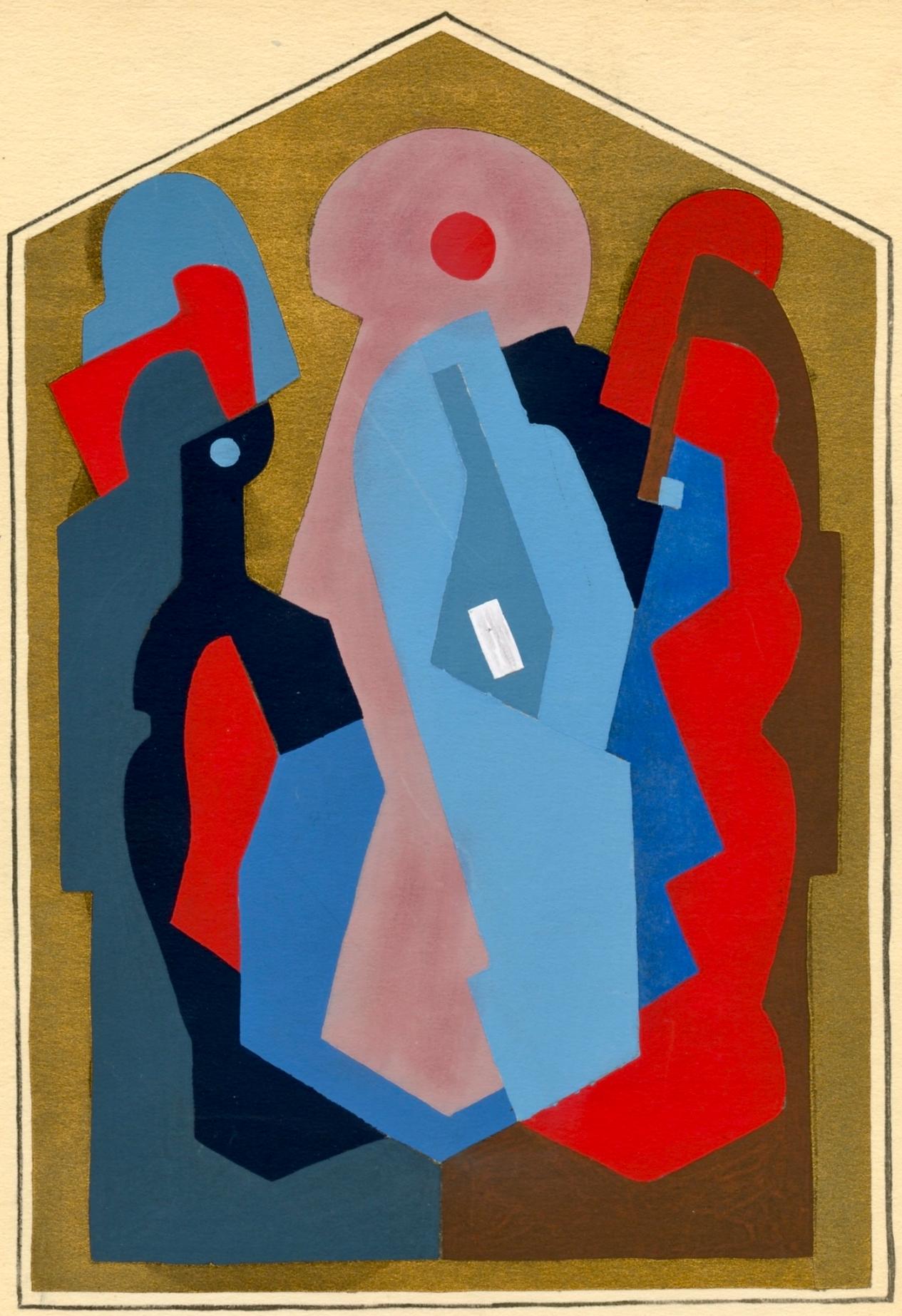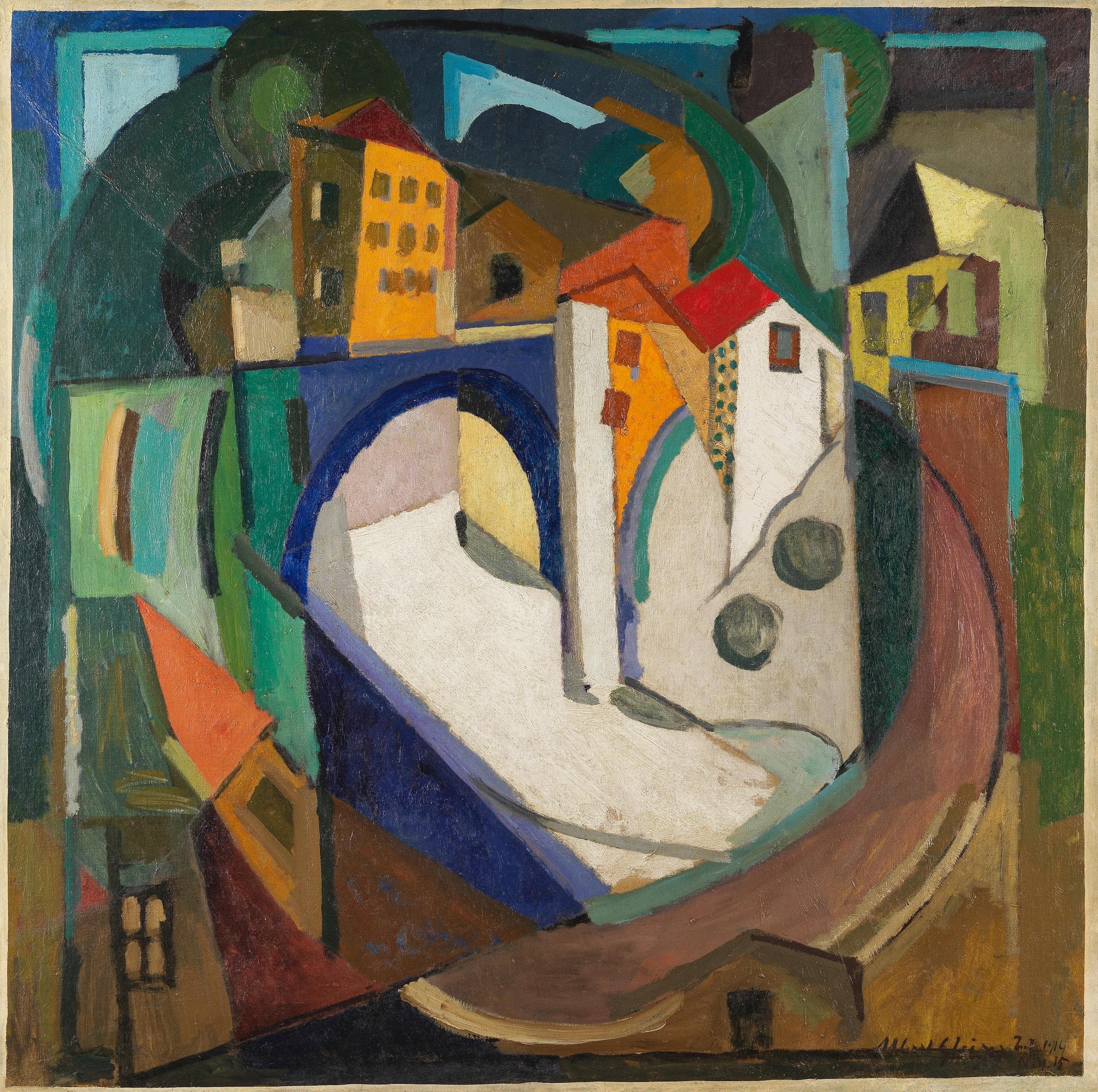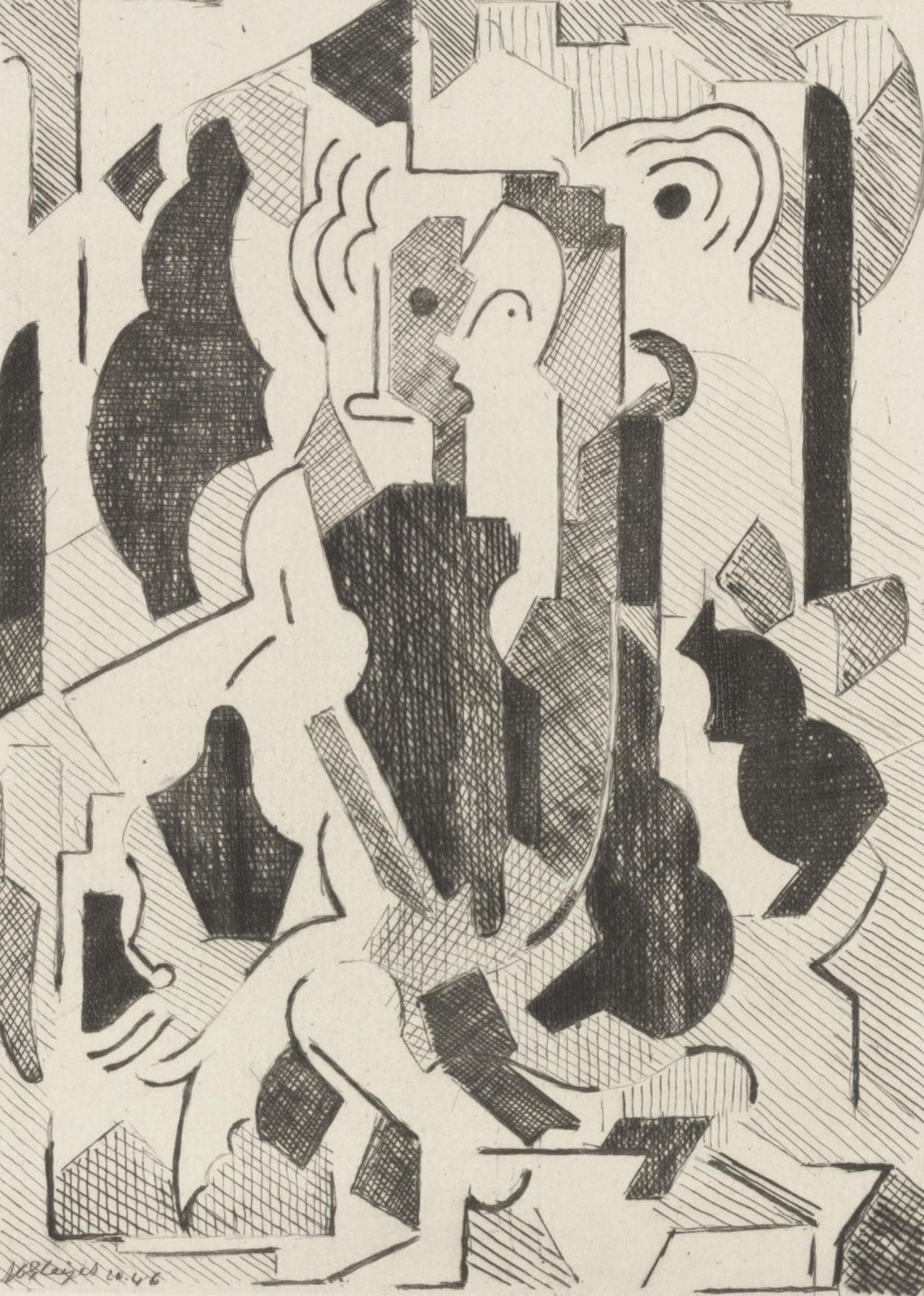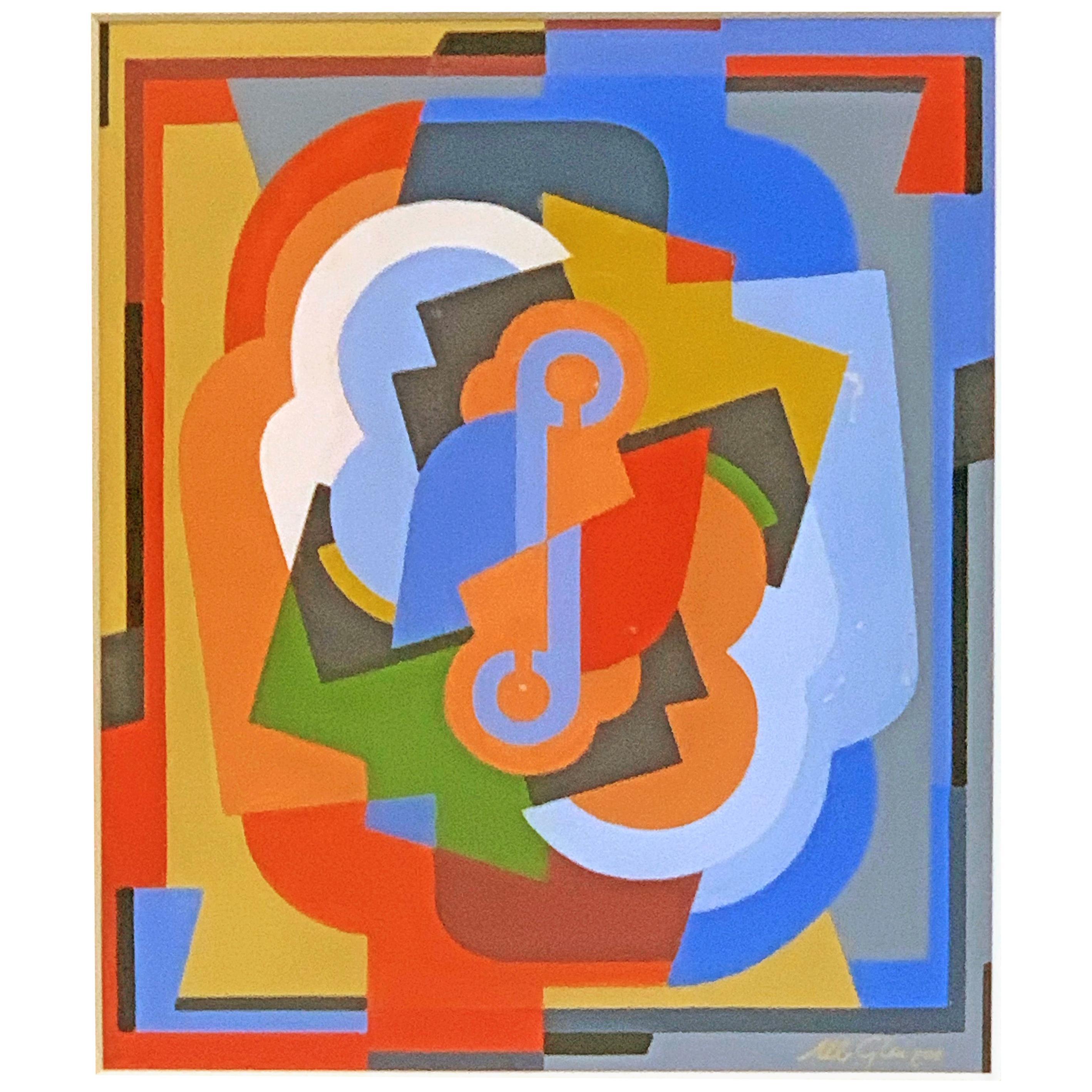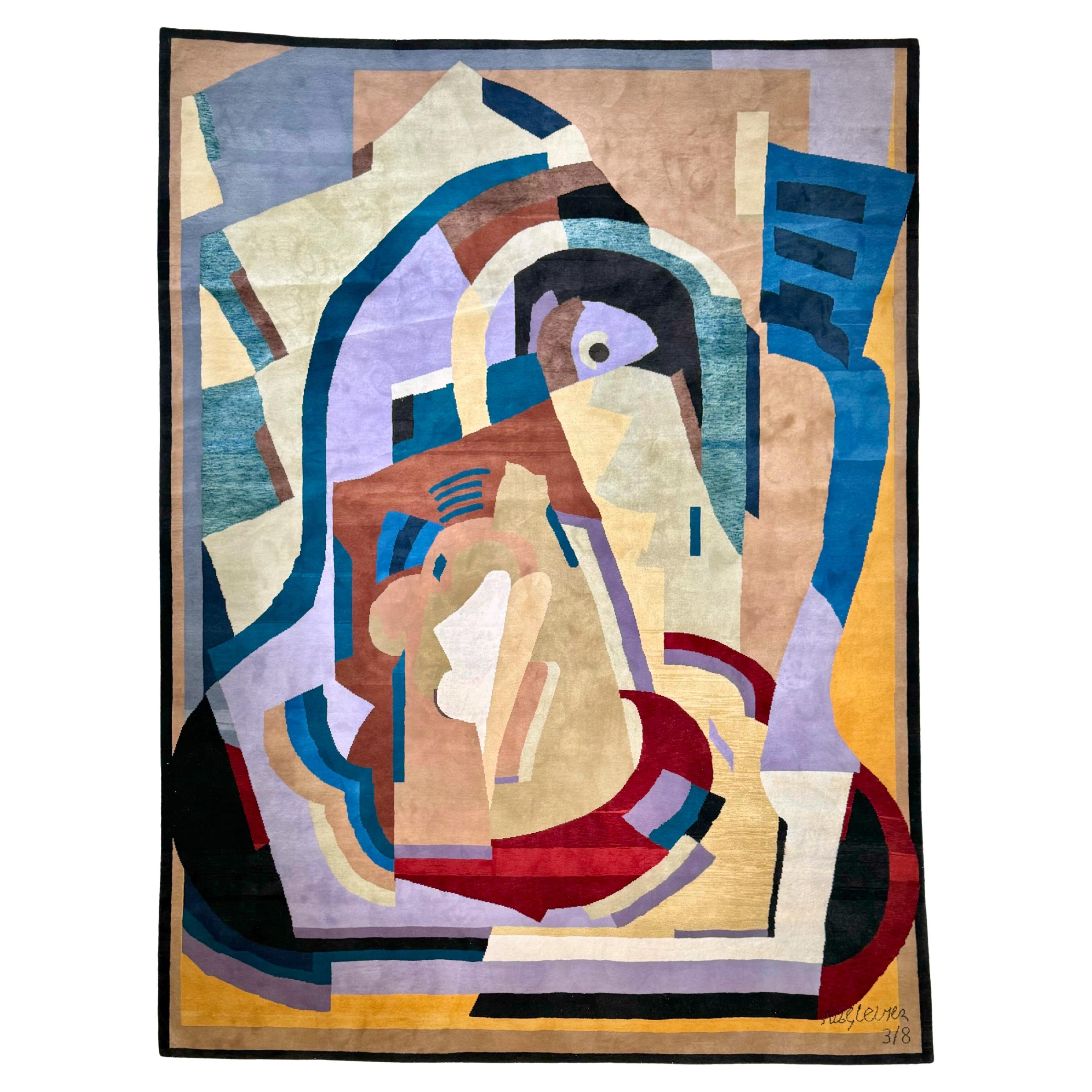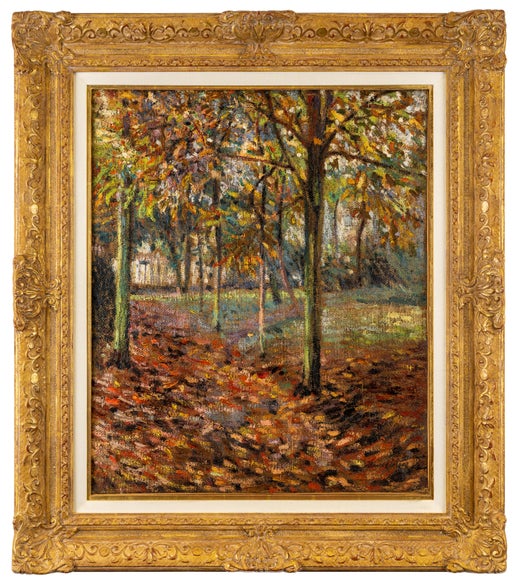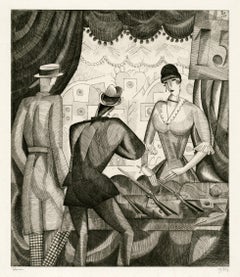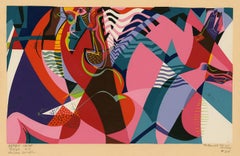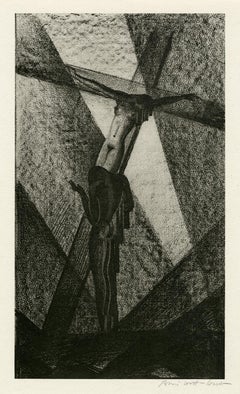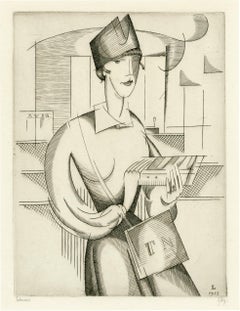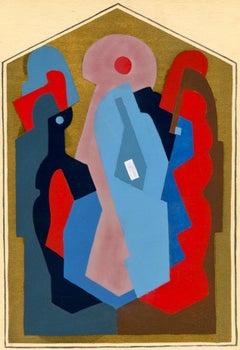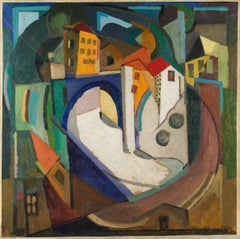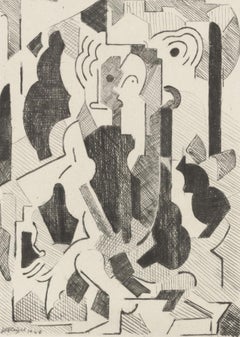Items Similar to 'Descente de Croix' (Descent from the Cross) — 1920s French Cubism
Want more images or videos?
Request additional images or videos from the seller
1 of 6
Albert Gleizes'Descente de Croix' (Descent from the Cross) — 1920s French Cubism1928
1928
$4,500
£3,425.63
€3,916.22
CA$6,331.56
A$6,925.69
CHF 3,646.56
MX$82,685.64
NOK 46,475.96
SEK 42,514.42
DKK 29,250.12
About the Item
Albert Gleizes, 'Descente de Croix', color pochoir, 1928, edition c. 50. Signed and dated in pencil. A fine, painterly impression, with fresh colors, on heavy, cream wove paper; the full sheet with margins (3 to 4 inches), in very good condition. The publisher's ink stamp 'EDITIONS MOLY-SABATA' beneath the image, lower left. Matted to museum standards, unframed.
Image size 12 x 14 inches (305 x 356 mm); sheet size 18 x 22 inches (457 x 559 mm).
ABOUT THE IMAGE
After the 1927 painting 'Descente de Croix', one of three religious-themed works that Gleizes developed as preliminaries for murals at the church at Serrières, France, the project was terminated at its final phase, and Gleizes commissioned master printer Robert Pouyaud to create prints of the paintings, closely overseeing the production.
ABOUT THE MEDIUM
Pochoir is a refined stencil-based technique employed to create multiples or to add color to prints produced in other mediums. Characterized by its crisp lines and rich color, the print-making process was most popular from the late 19th century through the 1930s, with its center of activity in Paris. The pochoir process began with the analysis of an image’s composition, including color tones and densities. The numerous stencils (made of aluminum, copper, or zinc) necessary to create a complete image were then designed and hand-cut by the 'découpeur.' The 'coloristes' applied watercolor or gouache pigments through the stencils, skillfully employing a variety of different brushes and methods of paint application to achieve the desired depth of color and textural and tonal nuance. The pochoir process, by its handcrafted methodology, resulted in the finished work producing the effect of an original painting, and in fact, each print was unique.
ABOUT THE ARTIST
Albert Gleizes (1881-1953), born in Paris, France, was a pioneering figure in the development of abstract art and one of the leading proponents of Cubism. His contributions to the art world extended beyond his paintings; he was also a prolific writer and theoretician, advocating for a new approach to art that emphasized the geometric abstraction of form and a departure from representational traditions.
Gleizes initially studied painting at the Académie Julian and the École des Beaux-Arts in Paris, where he was exposed to the academic conventions of the time. However, his artistic vision was profoundly influenced by encounters with avant-garde movements, including Fauvism and the work of Paul Cézanne. These influences led Gleizes to experiment with form and color, gradually moving away from traditional representation toward a more abstract and geometric style.
After completing his secondary schooling, Gleizes spent four years in the French army and then began pursuing a career as a painter, primarily doing landscapes. Initially influenced by the Impressionists, he was only twenty-one years of age when his work titled ‘La Seine à Asnières’ was exhibited at the Société Nationale des Beaux-Arts in 1902. The following year, he was part of the first Salon d'Automne and soon came under the influence of Fernand Léger, Robert Delaunay, Jean Metzinger, and Henri Le Fauconnier. In 1907, Gleizes and some of his friends pursued the idea of creating a self-supporting community of artists that would allow them to develop their art free of any commercial concerns. For nearly a year, Gleizes , with other painters, poets, musicians, and writers, lived at a large house in Créteil, but a lack of funds forced them to give up their facility in early 1908, and Gleizes moved temporarily into La Ruche, the artist commune in the Montparnasse Quarter of Paris.
In the early 1910s, Gleizes became associated with the Cubist movement, which was spearheaded by artists such as Pablo Picasso and Georges Braque. Cubism sought to represent the multidimensional aspects of reality by breaking down forms into geometric shapes and exploring multiple perspectives within a single composition. Gleizes's contributions to Cubism were significant, as he co-authored the influential treatise "Du Cubisme" (On Cubism) with Jean Metzinger in 1912, outlining the principles and theories behind the movement.
With the outbreak of World War I, Albert Gleizes re-enlisted in the French army. He was put in charge of organizing entertainment for the troops and, as a result, was approached by Jean Cocteau to design the set and costumes for the William Shakespeare play, ‘A Midsummer Night's Dream.’ Discharged from the military in the fall of 1915, Gleizes and his new wife, Juliette Roche, the daughter of a prominent and wealthy French statesman, moved to New York City. From there, the couple sailed to Barcelona, Spain, where they were joined by Marie Laurencin, Francis Picabia, and his wife. The group spent the summer painting at the resort area of Tossa del Mar, and in December, Gleizes had the first solo exhibition of his works at the Galeries Dalmau in Barcelona. Returning to New York City, Gleizes began writing poetic sketches in verse and in prose. Traveling to Bermuda, he painted a number of landscapes, but when the war in Europe ended, he returned to France, where his career evolved into teaching through writing, and he became involved with the committee of the Unions Intellectuelles Françaises. In 1927, still dreaming of the communal days in Créteil, he founded an artist's colony at a rented house called the Moly-Sabata in Sablons near his wife's family home in Serrières in the Ardèche département in the Rhône Valley.
In 1931, Gleizes was part of the committee of Abstraction-Création that acted as a forum for international non-representational art. By this time, his work reflected the strengthening of his spiritual convictions, and his 1932 book, La Forme et l’histoire, examines Celtic, Romanesque, and Oriental art. On tour in Poland and Germany, he gave lectures titled Art et Religion, Art et Production, and Art et Science. In 1937, Gleizes was hired to paint murals for the Exposition Internationale des Arts et Techniques dans la Vie Moderne at the Paris World’s Fair. He collaborated with Delaunay in the Pavillon de l'Air and with Léopold Survage and Fernand Léger for the Pavillon de l'Union des Artistes Modernes. At the end of 1938, Gleizes volunteered to participate in the free seminars and discussion groups for young painters set up by Robert Delaunay at his Paris studio.
In the late 1930s, the wealthy American art connoisseur Peggy Guggenheim purchased a great deal of the new art in Paris, including works by Albert Gleizes. She brought these works to the United States, which today form part of the Peggy Guggenheim Collection. During World War II, Gleizes and his wife remained in France under the German occupation. His religious convictions deepened, and at the war's end, he was hailed by some as having laid out the principles for a renewal of religious art. In 1948, Gleizes accepted an offer from a publisher in Casablanca to create a series of etchings illustrating the ‘Pensées sur l'Homme et Dieu’ of Blaise Pascal. In 1951, he was made a jury member for the Prix de Rome, and the French government awarded him the Legion of Honor. In 1952, he completed his last major work, a fresco titled ‘Eucharist’ created for a Jesuit chapel in Chantilly.
Throughout his career, Gleizes remained dedicated to exploring the formal possibilities of abstraction while also incorporating elements of rhythm, color, and dynamic movement into his compositions. His style evolved over time, reflecting his ongoing engagement with modernist ideas and his interest in spirituality and metaphysics.
Albert Gelizes’ work is represented in numerous museums in the United States, the United Kingdom, and Europe including the British Museum (London), Los Angeles County Museum of Art, Musée d'Art Moderne de la Ville de Paris, Musée des Beaux-Arts de Lyon (Lyon, France), Musée de Grenoble (Grenoble, France), Musée National d'Art Moderne (Centre Georges Pompidou, Paris), Museum of Modern Art (New York), National Gallery of Art (Washington, D.C.), Peggy Guggenheim Collection (Venice, Italy), Solomon R. Guggenheim Museum (New York), The Metropolitan Museum of Art (New York), Philadelphia Museum of Art, Tate Modern (London).
- Creator:Albert Gleizes (1881-1953, French)
- Creation Year:1928
- Dimensions:Height: 12 in (30.48 cm)Width: 14 in (35.56 cm)
- Medium:
- Movement & Style:
- Period:
- Condition:
- Gallery Location:Myrtle Beach, SC
- Reference Number:Seller: 1011561stDibs: LU53235789942
Albert Gleizes
Albert Gleizes (1881-1953) was a prominent French artist, theorist, and philosopher, best remembered as a pioneer of Cubism alongside artists like Picasso and Braque. Born in Paris, his early work was influenced by Impressionism, but by 1910, he had delved deep into the innovative world of Cubism, emphasizing geometrical forms and multiple viewpoints. With Jean Metzinger, he co-authored "On Cubism," a significant treatise that helped define and explain the movement's principles. Throughout his career, Gleizes continued to evolve his style, moving towards abstraction and integrating his fascination with rhythm and color. In addition to his visual contributions, his writings made him an influential voice in 20th-century art theory. A true visionary, Gleizes not only reshaped the art world with his creations but also laid the groundwork for future abstract artists with his profound insights into the essence of art.
About the Seller
5.0
Recognized Seller
These prestigious sellers are industry leaders and represent the highest echelon for item quality and design.
Platinum Seller
Premium sellers with a 4.7+ rating and 24-hour response times
Established in 1995
1stDibs seller since 2016
334 sales on 1stDibs
Typical response time: 1 hour
Associations
International Fine Print Dealers Association
- ShippingRetrieving quote...Shipping from: Myrtle Beach, SC
- Return Policy
More From This Seller
View All'Le Tir Forain' (Fairground Shooting) — 1920s French Cubism
By Jean-Emile Laboureur
Located in Myrtle Beach, SC
Le Tir Forain, engraving, edition 108, 1920-21, Sylvain Laboureur 191. Signed and numbered '19/85 ép' in pencil. Initialed 'L' and dated 1920 in the matrix,...
Category
1920s Cubist Figurative Prints
Materials
Engraving
Sister Kate — Mid-century, Jazz-inspired Modernism
By James Houston McConnell
Located in Myrtle Beach, SC
James Houston McConnell, 'Sister Kate', color serigraph, 1947, edition 24. Signed, dated, titled, and numbered '24' in pencil. Annotated '10.00 - 19 colors - 24 copies - #24' in pencil. A fine impression, with vibrant, fresh colors, on heavy tan wove paper, with full margins (11/16 to 1 1/2 inches). Tack holes in the four margin corners, well away from the image, otherwise in excellent condition. Matted to museum standards, unframed. Scarce.
Another of McConnell's mid-century modernist, jazz-inspired serigraphs, 'Combo', is featured in the British Museum's 2008 publication (and traveling exhibition) 'The American Scene: Prints from Hopper to Pollock'.
ABOUT THE IMAGE
"I Wish I Could Shimmy Like My Sister Kate", often simply "Sister Kate", is an up-tempo jazz dance song, written by Armand J. Piron and published in 1922. The lyrics of the song are narrated in the first person by Kate's sister, who sings about Kate's impressive dancing skill and her wish to be able to emulate it. She laments that she's not quite "up to date", but believes that dancing like "Sister Kate" will rectify this, and she will be able to impress "all the boys in the neighborhood" like her sister.
Over the years this song has been performed and recorded by many artists, including Frances Faye and Rusty Warren, a 1959 version by Shel Silverstein...
Category
1940s American Modern Abstract Prints
Materials
Screen
Untitled (Crucifixion) — 1920s Modernism
By Boris Lovet-Lorski
Located in Myrtle Beach, SC
Boris Lovet-Lorski, 'Untitled (Nude Crucified)', lithograph, edition 250, 1929. Signed and numbered 19 in pencil. Number 19 of Volume 2, a series of 10 lithographs published by the a...
Category
1920s Art Deco Nude Prints
Materials
Lithograph
La Receveuse (Bill Collector) —French Cubism
By Jean-Emile Laboureur
Located in Myrtle Beach, SC
Jean-Emile Laboureur, 'La Receveuse', engraving, 1919, edition 8, first state of two (artist's proof). Laboureur, Godefroy 190.
Signed and numbered '3/8 ép' in pencil. Initialed and...
Category
1910s Cubist Figurative Prints
Materials
Engraving
'Arrangement with Blue Major' — Musically Inspired Modernist Abstraction
By Edward August Landon
Located in Myrtle Beach, SC
Edward Landon, 'Arrangement with Blue Major', color serigraph, edition 40, 1942, Ryan 9. Signed, titled, and annotated 'Edition 40' in pencil. A superb impression, with fresh colors, on cream, wove paper; the full sheet with margins (3/4 to 1 5/8 inches), in excellent condition. Image size 15 x 9 3/4 inches (381 x 248 mm); sheet size 17 15/16 x 11 3/4 inches (456 x 298 mm). Matted to museum standards, unframed.
'Arrangement with Blue Major' was selected for the landmark ‘Artists for Victory’ exhibition at the Metropolitan Museum of Art in 1942. Impressions of this work are also in the collections of the Asheville Art Museum, Five Colleges and Historic Deerfield Museum Consortium, Georgetown University (Special Collections), Mount Holyoke College Art Museum, Rutgers University, Smith College Museum of Art, and the Springfield Museum of Fine Arts.
ABOUT THE ARTIST
Born in Hartford, Connecticut, Edward Landon dropped out of high school to study art at the Hartford Art School. In 1930 and 1931, he was a student of Jean Charlot at the Art Students League in New York, after which he traveled to Mexico to study privately for a year with Carlos Merida. In 1933 he settled near Springfield, Massachusetts, painted murals in the local trade school, and exhibited with the Springfield Art League. His painting 'Memorial Day' won first prize at the fifteenth annual exhibition of the League at the Springfield Museum of Fine Arts. Landon became an active member of the Artists Union of Western Massachusetts, serving as president from 1934-1938.
Landon acquired Anthony Velonis’s instructional pamphlet on the technique of serigraphy in the late 1930s. With colleagues Phillip Hicken, Donald Reichert, and Pauline Stiriss, he began experimenting with screen printing techniques. The artists' groundbreaking work in screen printing as a fine art medium was the subject of the group’s landmark exhibition at the Springfield Museum of Fine Arts in 1940.
Landon became one of the founding members of the National Serigraph Society and served as editor of its publication, 'Serigraph Quarterly,' in the late 1940s and as its president in 1952 and 1953. The Norlyst Gallery in Manhattan held a one-person show of his prints in 1945. Awarded a Fulbright Fellowship in 1950, Landon traveled to Norway, where he researched the history of local artistic traditions and produced the book 'Scandinavian Design: Picture and Rune Stones...
Category
Mid-20th Century Abstract Abstract Prints
Materials
Screen
'Masken (Masks)' — German Expressionism, Bauhaus
By Lyonel Feininger
Located in Myrtle Beach, SC
Lyonel Feininger, 'Masken (Masks)' also 'Carnival Masks', woodcut, 1920, proofs only. Prasse W193. Signed and titled in pencil. Annotated '1973', the artist’s inventory number. A fin...
Category
1920s Bauhaus Abstract Prints
Materials
Woodcut
You May Also Like
Albert Gleizes, The Bathers, 1929 (after)
By Albert Gleizes
Located in Southampton, NY
This exquisite lithograph and pochoir after Albert Gleizes (1881–1953), titled Les Baigneuses (The Bathers), from the album L'Art Cubiste, Theories et Realisations, Etude Critique (C...
Category
1920s Cubist Still-life Prints
Materials
Lithograph, Stencil
Paysage
By Albert Gleizes
Located in London, GB
Mobilized in 1914, like many of his Cubist friends, Albert Gleizes was sent to a barracks in Toul, Lorraine, near the front line. Supported by a military doctor, Major Lambert, of wh...
Category
1910s Paintings
Materials
Canvas, Oil
Price Upon Request
Gleizes, Composition, Du cubisme (after)
By Albert Gleizes
Located in Southampton, NY
Drypoint on vélin du Lana Papiers Spéciaux pure rag paper. Unsigned and unnumbered, as issued. Good Condition. Notes: From the folio, Du Cubisme, 1947. Published by Compagnie Françai...
Category
1940s Modern Landscape Prints
Materials
Drypoint
Tribute to Albert Gleizes, 1935-40 - oil paint, 146x96 cm, framed
By R. Barlerin
Located in Nice, FR
Oil on plywood, signed lower right
Barlerin was disciple of Albert Gleizes.
Category
20th Century Cubist Abstract Paintings
Materials
Oil
"Cubist Forms in Blue and Red, " Brilliant Painting by Gleizes, Abstract Cubism
Located in Philadelphia, PA
One of the most brilliantly-hued paintings by Albert Gleizes we have seen, this highly abstract Cubist work is a rotating knot of curving forms in periwinkle, carmen, olive green, sky blue, burnt sienna and grey flannel, as vivid now as when it was painted a hundred years ago. Early in his life he was influenced by Fernand Leger, Robert Delauney...
Category
Vintage 1920s French Art Deco Paintings
Materials
Paint
$7,600 Sale Price
20% Off
Albert Gleizes, Design No. 41 - Artistic Wool Rug - French Modern Design
Located in New York, NY
-Albert Gleizes
-Tapestry after Design No. 41
-Woven in 2005, Design made 1915-25
-239 x 137 cm, 94 x 54 in
-Manufactured by Atelier Boccara
This handcrafted wool and natural silk r...
Category
Early 20th Century French Other Western European Rugs
Materials
Wool
